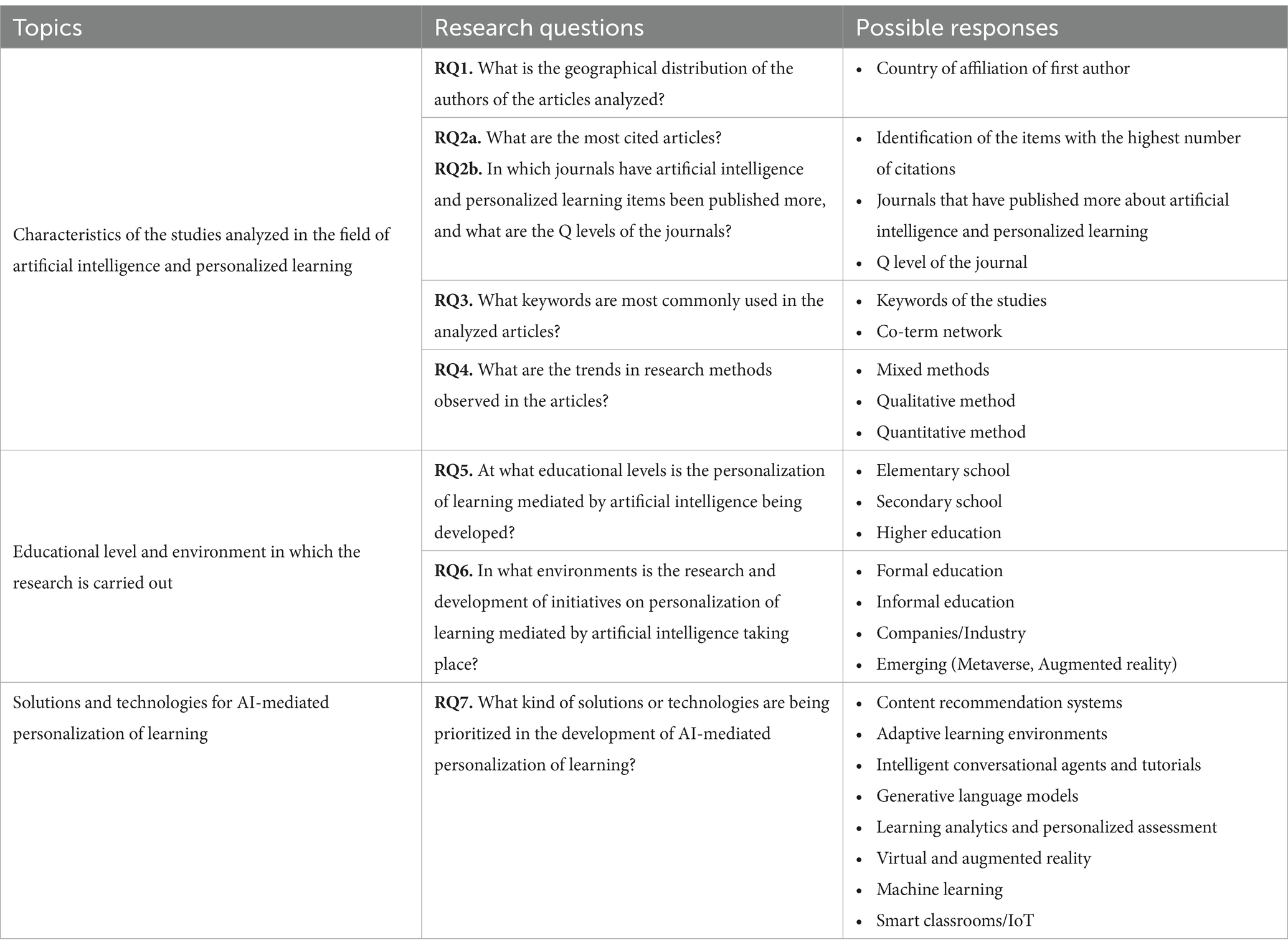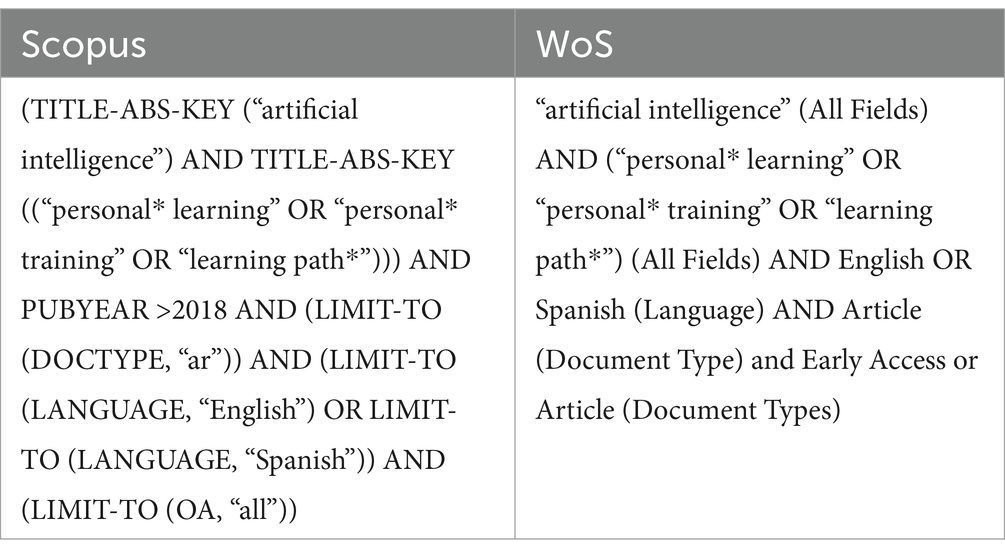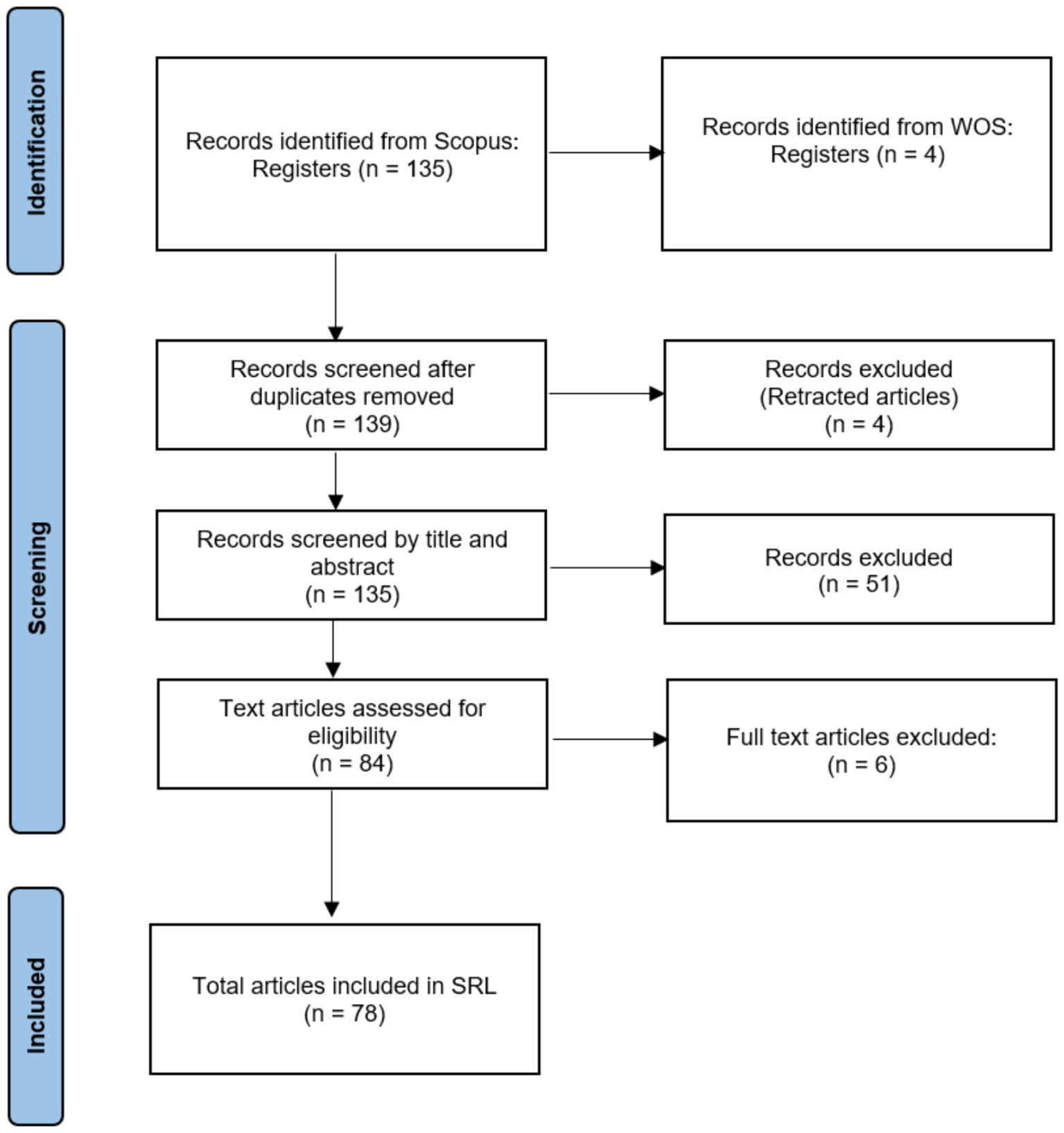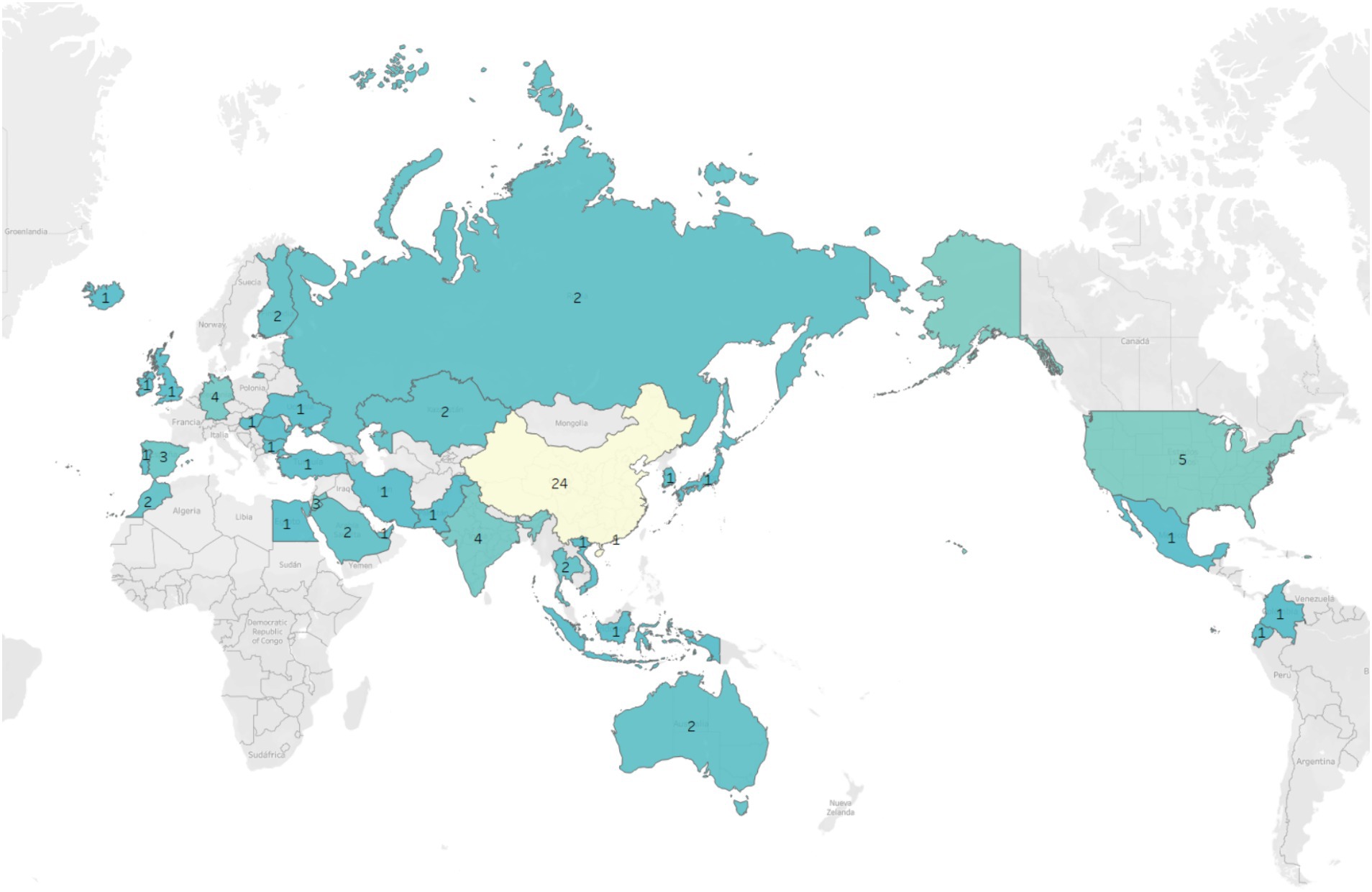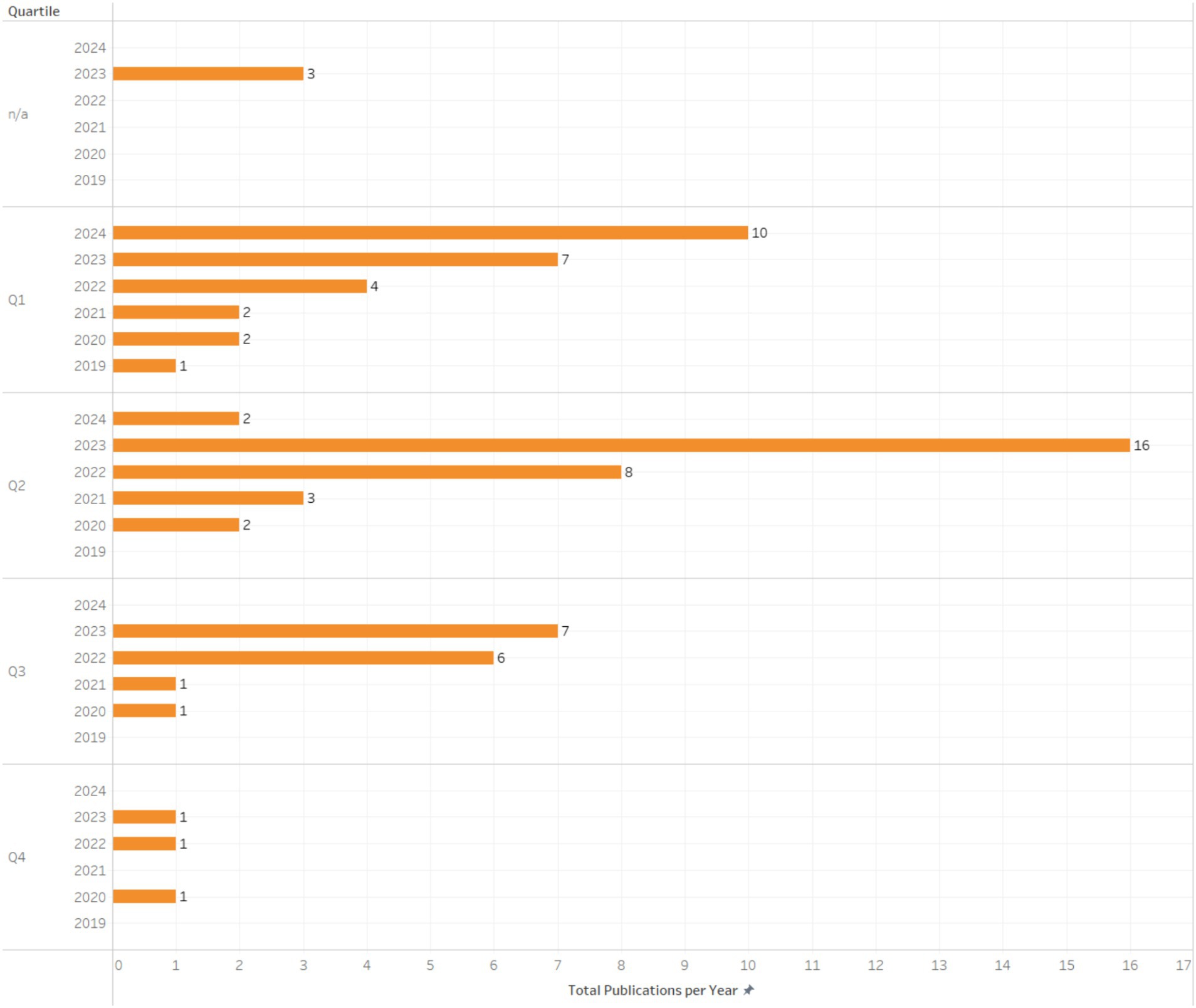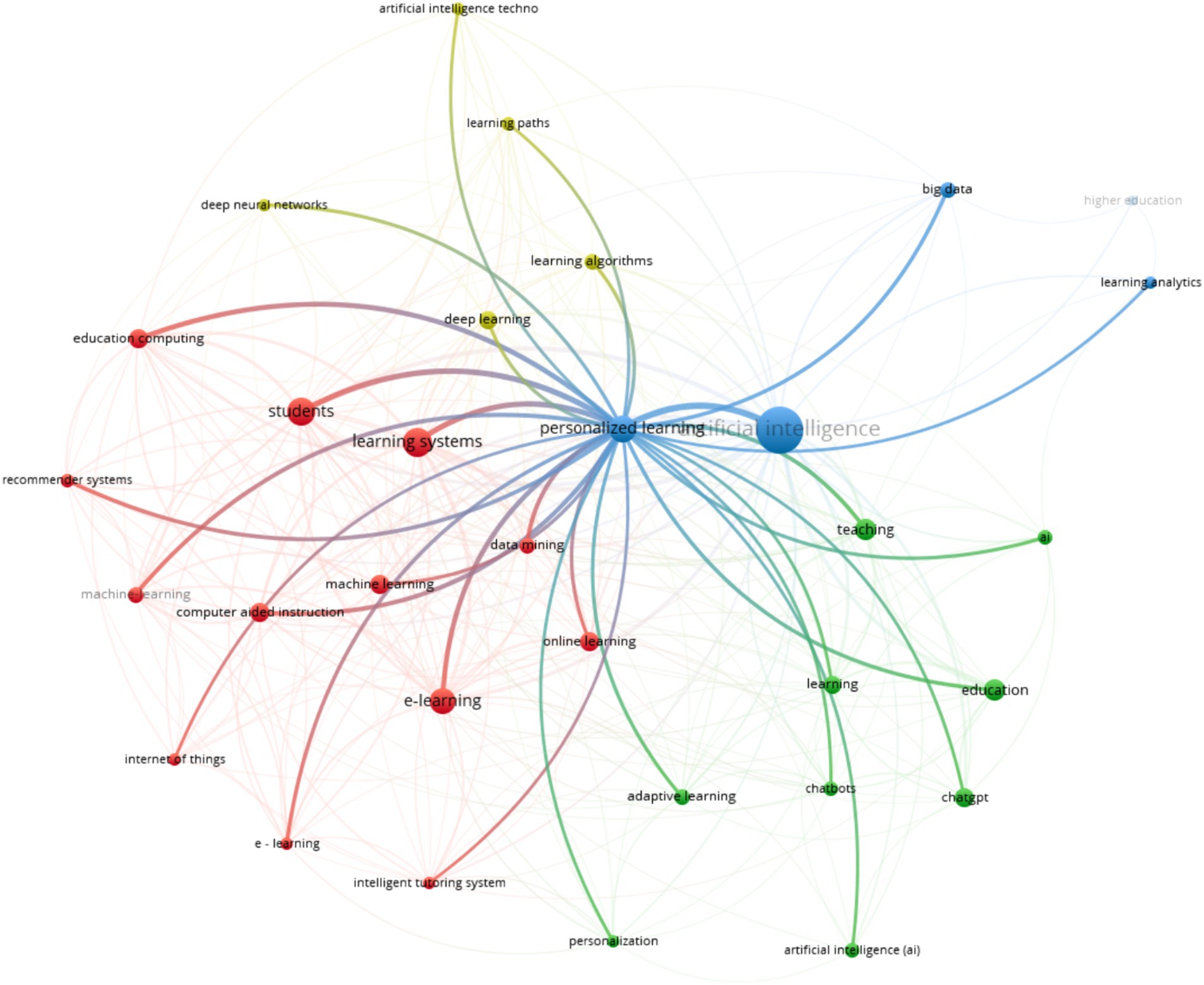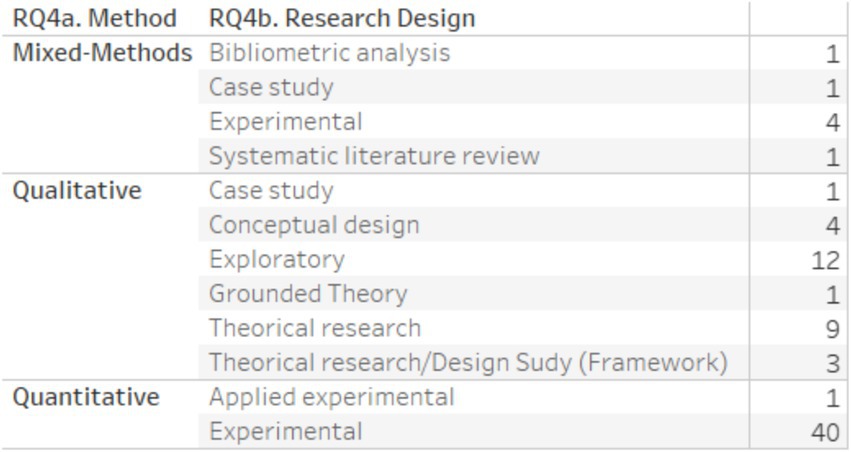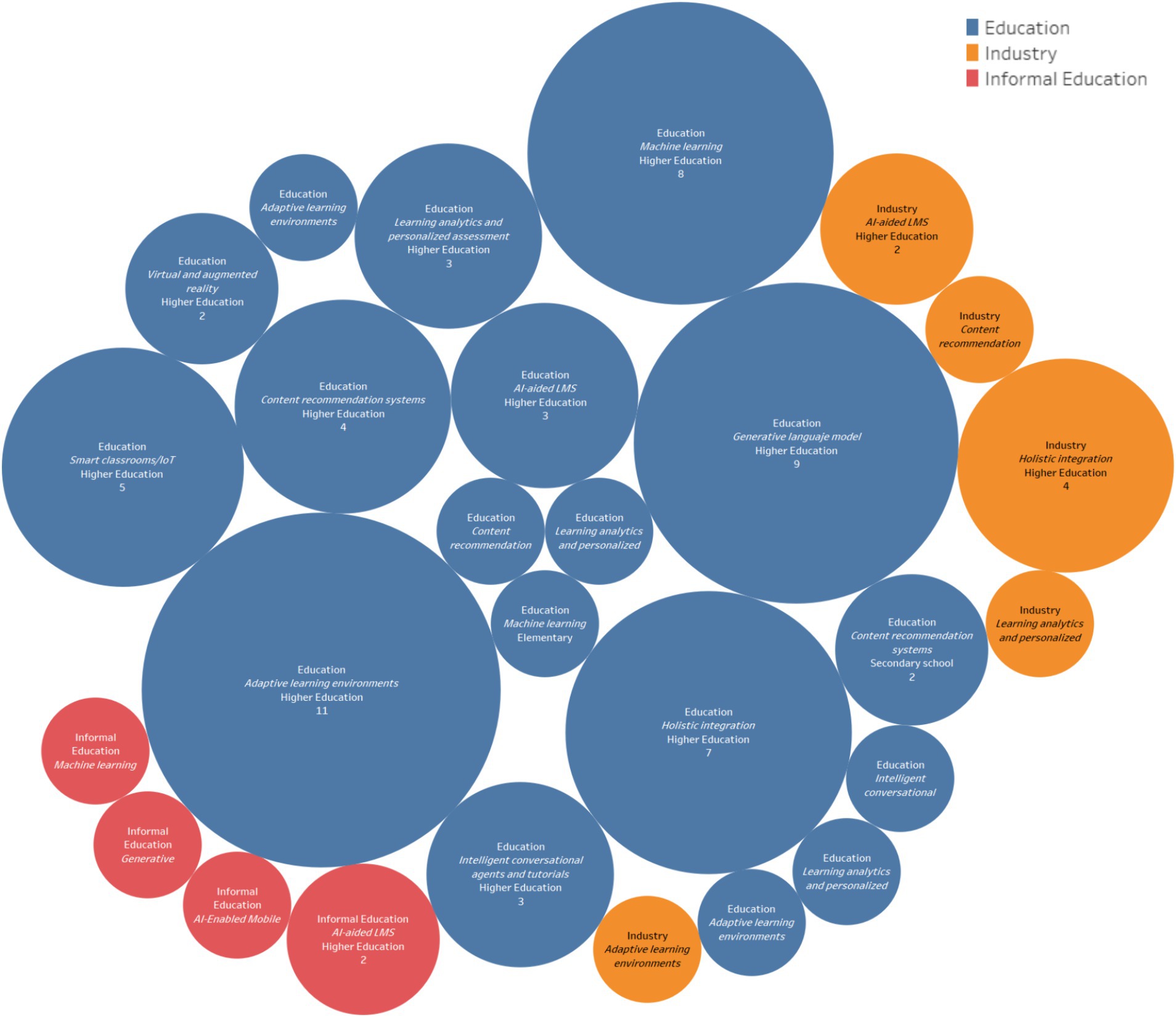- 1Business School, Tecnologico de Monterrey, Faculty of Informatics, Autonomous University of Querétaro, Monterrey, Mexico
- 2EGADE Business School, Institute for the Future of Education, Tecnologico de Monterrey, Monterrey, Mexico
- 3Faculty of Informatics, Autonomous University of Querétaro, Juriquilla, Mexico
The rapid evolution of knowledge requires constantly acquiring and updating skills, making lifelong learning crucial. Despite decades of artificial intelligence, recent advances promote new solutions to personalize learning in this context. The purpose of this article is to explore the current state of research on the development of artificial intelligence-mediated solutions for the design of personalized learning paths. To achieve this, a systematic literature review (SRL) of 78 articles published between 2019 and 2024 from the Scopus and Web or Science databases was conducted, answering seven questions grouped into three themes: characteristics of the published research, context of the research, and type of solution analyzed. This study identified that: (a) the greatest production of scientific research on the topic is developed in China, India and the United States, (b) the focus is mainly directed towards the educational context at the higher education level with areas of opportunity for application in the work context, and (c) the development of adaptive learning technologies predominates; however, there is a growing interest in the application of generative language models. This article contributes to the growing interest and literature related to personalized learning under artificial intelligence mediated solutions that will serve as a basis for academic institutions and organizations to design programs under this model.
Introduction
Today, lifelong learning has become an imperative to thrive in an ever-changing and evolving world. The quest for knowledge is no longer limited to traditional classrooms; instead, it has transformed into a personalized and adaptive journey that spans a lifetime. The individual’s life cycle can no longer be divided into a period of preparation followed by a period of action, but rather learning extends throughout all stages of life (UNESCO, 2022). Promoting lifelong learning means creating systems that realize the right to education for people of all ages and provide opportunities to unleash their potential. Within the framework of the Sustainable Development Goals (SDGs) as guiding axes of the 2030 Agenda of the United Nations Educational Scientific and Cultural Organization (UNESCO), SDG 4 promotes ensuring inclusive quality education and promoting lifelong learning opportunities for people (UNESCO, 2017). The Organization for Economic Cooperation and Development (OECD) proposes four fundamental characteristics for lifelong learning: a systematic vision that includes both formal and informal educational contexts, the centrality of the learner by placing him/her as the focus of learning, the motivation to learn by developing the ability to “learn to learn” through self-regulated and self-directed learning, and the focus on a multi-objective education where learning priorities and goals can be transformed throughout the individual’s life (OECD, 2009), in addition to the above, the recognition of the evolution of the concept of a single job for life makes it imperative for workers’ organizations to direct their efforts towards the development of new skills and lifelong learning (Organización Internacional del Trabajo, 2020). With a view to increasing the life expectancy and quality of life of individuals, the study and development of lifelong learning options is becoming increasingly relevant.
Despite the growing recognition of the importance of lifelong learning, there is a significant gap in understanding how to effectively personalize learning experiences to meet the diverse and evolving needs of individuals throughout their lives. Traditional educational methods often fall short in providing the flexibility and adaptability required for lifelong learning. This gap necessitates the exploration of innovative solutions to enhance the personalization of learning experiences.
In this context, artificial intelligence (AI) emerges as a powerful and transformative ally, enabling the creation of personalized and effective learning experiences capable of adapting to the priorities and needs of the individual at a specific point in his or her life. The integration of AI-assisted learning solutions are key to the modernization of education as they have the ability to create motivating and quality learning environments (Zhang et al., 2023). Artificial intelligence chatbots, for example, can provide individualized instruction and feedback based on the needs and progress of each learner, revolutionizing the concept of personalized learning (Osamor et al., 2023). With the advent of generative language models, AI has reached new heights of capability and versatility, sparking unprecedented interest in its application for the design of learning trajectories (Ifelebuegu, 2023). Because of its ability to transform education by offering motivating and personalized experiences that are tailored to individual needs, AI is positioned as an ally for lifelong learning.
The application of AI in educational contexts is not only based on the development of learning objects or tools for their creation but encompasses a wide range of applications. For the personalization of AI-mediated learning, researchers can opt for solutions such as mobile learning, educational games, collaborative learning in social networks, MOOCs or the application of augmented reality, among many others (Hamal et al., 2022; Del Campo et al., 2023), without leaving aside the conversion towards an assessment of learning focused on complex thinking skills, avoiding the implicit risk of bad practices in the use of AI by students that constitute a threat to the legitimacy of online assessment and academic integrity (Ifelebuegu, 2023). It is necessary, then, to consider that the use of IA in the educational context involves risks and limitations, among which are the problems of privacy, misinformation, plagiarism, biases and cultural differences and the lack of human connection, as well as other ethical implications, especially the gaps that may arise between students with access to these new technologies and those students who will be left behind due to the impossibility of access to these new educational models (Wang et al., 2023; Bulathwela et al., 2024). Finally, it is important to note that the adoption of AI is not in itself the answer to meet the educational challenges in higher education and its use must be accompanied by a correct pedagogical design (O’dea and O’Dea, 2023; Osamor et al., 2023). The adoption of AI in the educational context implies enormous advantages, however it is necessary to adopt a careful approach that allows minimizing its risks and maximizing its benefits in the development of solutions for the personalization of learning under a sound pedagogical design as an indispensable complement to this process. This research uses systematic literature review (SLR) to identify design strategies for artificial intelligence solutions in learning personalization. It aims to provide a broad overview of the current state of AI in learning personalization, highlight key areas of research, and advance the use of AI to enhance personalized learning in lifelong learning by proposing recommendations based on the findings to advance the integration of AI in personalized lifelong learning environments. The results contribute to the advancement of AI in learning personalization, key to educational innovation.
Literature review
Lifelong learning
The growing need for adults to acquire new skills and knowledge to advance their careers, address personal problems, or start and manage ventures has generated a growing interest in designing online education programs that are tailored to their specific needs and characteristics. In today’s evolving work environment, students entering the job market must demonstrate not only performance, but also collaboration, negotiation, planning, and organizational skills (Partnership for 21st Century Learning, 2019). The labor market is experiencing a shift toward complex “hybrid” jobs with emerging roles. This transition reflects a movement from manufacturing to service-oriented industries, reducing the demand for mechanical-routine workers and emphasizing the need for autonomous, flexible, and creative individuals capable of problem solving (Chiappe et al., 2020). The European Area of Lifelong Learning (2021) defines lifelong learning as any learning activity undertaken throughout life to improve knowledge, skills and competences with a personal, civic, social or occupational perspective. Adult education, especially in the context of lifelong learning, is a field that has become increasingly important in an ever-changing world. The idea that learning is a continuous process throughout life has become a fundamental principle.
Lifelong learning is crucial for the continued development and progress of individuals throughout their lives. Lifelong learning is important for several reasons. Firstly, it allows individuals to continuously acquire new knowledge and skills, enabling personal and professional growth throughout their lives (Merriam et al., 2007). Secondly lifelong learning also promotes community well-being and contributes to social cohesion (Merriam and Kee, 2014). Thirdly, it can enhance political stability and non-violence by fostering a culture of learning and knowledge acquisition (Asongu and Nwachukwu, 2016). Fourthly lifelong learning is crucial for adapting to the changing demands of the labor market, as it helps individuals stay relevant and employable (Schultheiss and Backes-Gellner, 2023), and lastly, it can also promote equality by providing opportunities for disadvantaged individuals to access education and improve their socio-economic status (Hällsten, 2011). In summary, lifelong learning is crucial to adapt to the changing demands of the labor market, promote equality and improve individual and community well-being, a tool that can help enhance the acquisition of new skills and knowledge for adults in a flexible environment and that advances at great speed thanks to AI for its ability to generate flexible and adaptable environments for the learner.
Artificial intelligence
In the current era, characterized by rapid technological evolution and the growing need for continuous adaptation, artificial intelligence emerges as an invaluable resource that transforms and enriches the educational landscape, offering personalized and motivating solutions that enhance lifelong learning. AI plays a crucial role in adult and lifelong learning. Lifelong learning aims to emulate the capability of humans to continuously acquire knowledge and skills throughout their lives (Chen and Liu, 2018). AI systems can support lifelong learning by providing personalized and adaptive learning experiences, allowing individuals to learn at their own pace and according to their specific needs (Ally and Perris, 2022). AI can enhance learning efficiency and cognitive abilities, improving teaching and learning outcomes (Huang et al., 2021). Additionally, AI can automate the construction of visual–linguistic knowledge, enabling continuous knowledge construction for lifelong learning (Ha et al., 2015). The use of AI in education can transform learning into an ongoing, lifelong process (Tang and Deng, 2022). AI supports ongoing initiatives to promote lifelong learning by providing tailored and adaptable experiences. Moreover, AI aids lifelong learning through automated assessment and progress tracking (Sanabria-Z et al., 2023). Overall, AI has the potential to revolutionize adult and lifelong learning by providing personalized, adaptive, and continuous learning experiences.
Despite the growing importance of online adult education and the existence of effective design principles, relatively little attention has been paid to how to adapt these principles to adult learning, specifically those seeking to acquire new skills related to adapting to changing work environments. Massive open online courses (MOOCs) have triggered a sudden change in the educational scene. Its characteristics of being free, heterogeneous, multi-thematic, and fostering lifelong learning have completely changed the instructional design scene, allowing these innovations and new architectures of teaching and learning to be included (Valenzuela et al., 2019). In this sense, Conget et al. (2021) point out that lifelong learning benefits both from feedback that elicits reflection on learning as well as the promotion of curiosity, motivation, perseverance and regulation of learning. Lifelong learning empowers individuals to have control over their own learning agenda and shape their own lives (Eynon and Malmberg, 2021). As adult learners may differ significantly from younger learners, learning design based on andragogical principles and focused on the pragmatic and context-dependent needs of learners calls for consideration of incorporating frameworks on lifelong learning for learning design. Overall, lifelong learning is essential for personal development, societal progress, and economic prosperity.
Personalized learning
Personalized learning has become a key approach in contemporary education. In a world where universal approaches are no longer appropriate, personalized learning requires education to provide customized solutions to students according to their particular needs. This represents a significant shift from traditional teacher-centered models. However, the reality of education in schools, especially in developing countries, is far from being flexible, personalized, oriented to the development of soft skills, and based on the use of information and communication technologies (Chiappe et al., 2020). The U.S. Office of Educational Technology defined personalized learning as “instruction tailored to the specific learning needs, preferences, and interests of diverse learners” (Peters and Araya, 2011). In a personalized educational environment, learning objectives and content, as well as method and pace, may vary, so personalization encompasses differentiation and individualization. Personalization of learning can be based either on the cognitive characteristics or behavioral traits of learners but also on their learning style, level of knowledge or learning preferences (Nguyen and Nguyen, 2023). Personalization of learning enables the improvement of both academic performance and the enhancement of student’s digital skills (Yang and Wen, 2023). However, it is not without its challenges, mainly in terms of social skills development due to the lack of community learning environments, which can isolate students and prevent them from acquiring the skills needed in a work environment (Pence, 2020). The personalization of learning represents an enormous advantage, not only in terms of improving the student’s academic performance and the development of digital skills, but also in terms of the needs of adult learning in work contexts with a focus on lifelong learning.
Notwithstanding the efforts made for the incorporation of personalization of learning in the educational system, it still presents challenges that need to be faced. It is necessary to expand the existing knowledge on the design of learning itineraries in terms of actors involved, personalization strategies, pattern language, structure and ways to evaluate the results of the implementation (Buitrago et al., 2021). Personalized learning challenges include a lack of unified agreement on the components needed for a dynamic, personalized learning approach, which can provide unique and effective learning experiences. It should consider learner profiles, prior knowledge, adaptive learning paths, and flexible self-paced environments, with learning analytics generating dynamic environments (Shemshack et al., 2021). Personalization is most successful when relevant learner characteristics are measured repeatedly during the learning process and used to adapt instruction in a systematic way (Tetzlaff et al., 2021). A successful personalized learning system balances making the best recommendations based on current knowledge and exploring new learning trajectories that may pay off (Tang et al., 2019). In summary, to delve into the design of learning pathways and overcome the challenges that the implementation of personalized learning represents, it is crucial to foster effective and adaptive educational experiences that cater to the diverse needs and preferences of learners.
Method
In order to establish the basis for the exploration of artificial intelligence-mediated personalization of learning as a response to the growing need to establish a continuum of lifelong learning and professional development, a systematic literature review (SRL) was conducted. The SRL method allows identifying, analyzing and interpreting evidence related to the research objective in an unbiased and repeatable way (García-Peñalvo, 2017) being a process that synthesizes research in a systematic, transparent and reproducible way in order to enrich knowledge and inform policy making and practice (Tranfield et al., 2003). The process consisted of (1) the formulation of research questions, (2) the selection of databases and search terms or keywords for the preliminary mapping of articles published on the topic in question as part of the search process, (3) the selection of quality criteria for the inclusion and exclusion of articles to be reviewed, (4) the selection and extraction of data and, finally, (5) the synthesis of information that would allow answers to the research questions defined (Kitchenham and Charters, 2007; Landa et al., 2011). The control of this process was carried out following the guidelines established by the PRISMA (Preferred Reporting Items for Systematic Reviews and Meta-Analyses) statement (Page et al., 2021).
Research questions
The research questions were established in order to analyze published articles on artificial intelligence-mediated solutions for personalization of learning, published in the last five years. These seven research questions were designed to address three topics of interest:
1. Characteristics of the studies analyzed in the field of artificial intelligence and personalized learning.
2. Educational level and environment in which the research is carried out.
3. Solutions and technologies for AI-mediated personalization of learning.
The choice of research questions was based on the following criteria:
1. Relevance: the questions had to be relevant to the research topic, which is artificial intelligence applied to learning personalization.
2. Accuracy: The questions had to be precise and concise, to facilitate their understanding and response.
3. Feasibility: The questions had to be feasible to answer, taking into account the limitations of the research.
The research questions formulated are described in Table 1.
Search process
The search for articles was performed on February 26, 2024, in the Scopus and Web of Science (WoS) databases. The keywords chosen were: artificial intelligence and personalized learning, the search period: 2019 to 2024 and the document type: article, with the publication languages: English or Spanish, were the delimiters. The search strings are shown in Table 2.
Inclusion and exclusion criteria
The Scopus and Web of Science (WoS) databases were used to search for articles. The search terms used were: Artificial intelligence, Personal learning, Personal training, and Learning path. For the elaboration of this review, the following categorization of criteria for the inclusion of information was carried out:
1. Thematic: Artificial intelligence and Personalized learning.
2. Spatial: It was decided not to establish a geographical restriction. Worldwide research is included only in English language.
3. Temporal: Papers published during the last five years are included, starting in 2019.
4. Type of document: Research articles.
5. As criteria for exclusion of information, it was established that documents lacking a theoretical or conceptual framework would be eliminated, as well as those that did not meet the previously established inclusion criteria.
Selection process and data extraction
The number of articles found in both databases (Scopus and WoS) was 139. Following quality criteria, four records corresponding to articles withdrawn from the publications were eliminated to proceed to a review of titles and abstracts in order to identify those articles that corresponded to the focus of interest of this publication in terms of type of document and relationship with the topic, leaving a total of 78 articles selected for the SRL, from which the following information was extracted: Title, Author, DOI, Abstract, Name of the publication, Number of citations and Country of the first author. This information was compiled in an Excel file available for consultation. Figure 1 shows the selection process of articles included in the SLR.
Data extraction and synthesis
Before writing the narrative synthesis, the 78 selected publications were carefully read and summarized in the context of the research questions. Given the newness of the research in the field there was, to the authors’ knowledge, no definitive classification proposed for the type of artificial intelligence solutions used for learning personalization, so, to answer question RQ7 a classification of our own was created based on the classifications proposed by Hashim et al. (2022) and Bozkurt et al. (2021) which includes the categories: (1) Adaptive learning environments, (2) AI-aided LMS, (3) AI-Enabled Mobile Apps, (4) Content recommendation systems, (5) Generative language model, (6) Holistic integration, (7) Intelligent conversational agents and tutorials, (8) Learning analytics and personalized assessment, (9) Machine learning, (10) Smart classrooms/IoT, and (11) Virtual and augmented reality.
Results
This section presents the results obtained from the meticulous and systematic analysis of the data collected. The articles under analysis are integrated in Supplementary Material, with an identification number, in order to identify them in some of the results.
RQ1. What is the geographical distribution of the authors of the articles analyzed?
In order to identify the regions of the world that are currently leading research on personalization of learning through artificial intelligence-assisted solutions, the geographical dispersion of the first authors of the articles reviewed was analyzed. Figure 2 shows that the highest concentration of authors is located in China outnumbering in a ratio of about 5:1 the next concentration located in the United States, followed by India and Germany. The areas with low scientific production on the subject are in Africa and Latin America.
The study of the geographic distribution of authors with interest in the subject allows us to identify the regions of the world where there is an area of opportunity for the development of research, especially if we consider that the personalization of learning requires adapting it to the characteristics of the student, which may be influenced by both culture and place of origin.
RQ2. In which journals have artificial intelligence and personalized learning items been published more, and what are the Q levels of the journals?
To understand which academic journals are leaders in the publication of articles related to artificial intelligence and personalized learning, we analyzed the total number of published articles as well as the year of publication and the quartile of classification of the journal. It was found that 37% of the published articles are grouped in 8 journals at the Q1 and Q2 levels: International Journal of Emerging Technologies in Learning (6), Applied Mathematics and Nonlinear Sciences (5), Sustainability (Switzerland)(4), IEEE Access (4). Education Sciences (4), Frontiers in Psychology (3), Frontiers in Education (3). The analysis by quality levels (Q levels) of the journals indicates that 73% of the articles reviewed were published in journals with Q1 and Q2 level (Figure 3).
The identification of publications and their quality level allows authors to identify sources for the dissemination of their research results through clarity on the perceived quality of research on personalization of learning and artificial intelligence as well as informed decision making for the development of strategies to raise the overall standard of research on the topic.
RQ3. What keywords are most commonly used in the analyzed articles?
The identification and analysis of keyword co-occurrence in the 78 articles reviewed made it possible to detect and group the concepts that are related to the key terms of this research: personalized learning and artificial intelligence. Figure 4 allows identifying the relationship between the term “personalized learning” and the four groupings of words, indicated by color, among which can be grouped those referring to learning analytics as a way to evaluate learning effectiveness, deep learning algorithms, the different personalization solutions mediated by artificial intelligence among which “e-learning,” “machine learning” and “learning systems” stand out. It is worth noting the grouping corresponding to generative language models where ChatGPT occupies an important place despite the novelty of its appearance in practice.
The keyword co-occurrence analysis allows identifying predominant themes and areas of interest in the academic literature, as well as emerging trends and possible gaps in knowledge. The groupings in terms of artificial intelligence-mediated solutions for learning personalization reflect the main trends in educational practice and confirm the classification proposed for the development of this research.
RQ4. What are the trends in research methods observed in the articles?
The analysis of trends in research methods and design allows inferring the preferred methodological approaches for research on learning personalization and artificial intelligence. The classification of articles was done in terms of quantitative methods (experimental design, quasi-experimental, applied experimental), qualitative methods (case study, conceptual design, exploratory, descriptive, grounded theory, theoretical research) and mixed methods (bibliometric analysis, case study, experimental, and systematic literature review) (Bauer, 2000; Valenzuela and Flores, 2013). The review of research methods and designs results in a concentration of more than 50% of the articles reviewed whose research was conducted under a quantitative research method in an experimental research design. It should be noted that among the articles with the highest number of citations are studies conducted under a qualitative approach: A-131 with 64 citations on business models for the application of learning analytics and artificial intelligence for the development of learning solutions (Renz and Hilbig, 2020), A-138 with 47 citations that explores whether artificial intelligence-mediated solutions can be applied in an enterprise learning environment for talent development (Maity, 2019) A-132 with a state-of-the-art review on personalization of learning and exposing gaps in creating and maintaining motivation for learning, a focus on diversity, and eliminating data-and algorithm-induced biases (Maghsudi et al., 2021), and A-056 on the advantages of using ChatGPT in the educational context, with 29 citations each (Sallam et al., 2023). The results of this review are detailed in Figure 5.
The study of research methods and designs applied to the topics of interest is useful to determine their state of maturity since a tendency towards experimental and exploratory approaches denotes novelty in the topic and the existence of important gaps and areas of opportunity and convergence for future research.
RQ5. At what educational levels is the personalization of learning mediated by artificial intelligence being developed?
RQ6. In what environments is the research and development of initiatives on personalization of learning mediated by artificial intelligence taking place?
RQ7. What kind of solutions or technologies are being prioritized in the development of AI-mediated personalization of learning?
In order to identify the educational contexts and the kind of solutions towards which the research on personalized learning and artificial intelligence is directed, the classification of articles was made under three headings: Educational (encompasses primary education, secondary education and higher education), Industry (refers to the application in the workplace and/or in organizations) and Informal Education (that available outside the scope of formal education), finding that more than 80% of the research is conducted in the educational context with a prevalence of 86% in higher education, while only 11.5% of the articles reviewed have a focus on learning within the work context and 6.5% in the context of informal education. Within this context, the study of artificial intelligence under a holistic approach stands out (44%) and only two of the articles reviewed, whose first authors are located on the Asian continent, focus on a specific solution. In A-050, the authors point out the imperative need to establish large-scale rapid retraining systems for the workforce, anticipating that smart and virtual workplaces will replace traditional offices, and thus an artificial intelligence-based framework for rapid retraining of job skills is presented (Ashrafi et al., 2023). In A-113, the authors propose a Blended Learning model for the assignment of learning paths based on the evaluation of knowledge acquisition with a focus on higher education applied in work contexts for the development of lifelong learning (Bekmanova et al., 2021). The results of this analysis are shown in Figure 6.
In the educational context, the study of solutions focused on Adaptive Learning (11) predominates, followed closely by Generative Language Models (9): A-002, A-005, A-010, A-015, A-023, A-045, A-056, A-057, A-093 and A-040.
The analysis of the educational levels in which the development of solutions for the personalization of learning is studied allows identifying areas of opportunity in the expansion towards contexts where the solutions for the personalization of learning are applicable in the format of continuing education or lifelong learning for the development of work competencies as well as the development of Adaptive Learning solutions taking into account the characteristics of the adult population as well as the use of Generative Language Models for the integration of training programs for adults.
Discussion
After analyzing 78 articles published in the Scopus and Web of Science databases between 2019 and 2024, the main findings and recommendations for future research are presented.
The study of personalization of learning through mediated solutions is not yet widespread as research is concentrated in a small number of countries. Figure 2 shows the geographical concentration of authors on the topic finding that the largest production comes from China, followed by far by the United States and India. The above coincides with the findings of other research (Nguyen and Nguyen, 2023) and allows highlighting the need not only for further research on the subject but also for its geographical dispersion, since the risks exposed by Bulathwela et al. (2024) and Wang et al. (2023) point out the lack of democratization in the personalization of learning due to the existence of gaps in access, which will disadvantage students in countries lagging behind in the application and implementation of these solutions. The dissemination of the relevance of the topic is important to motivate research throughout the world.
Regarding the relevance of research on the topic, it is clear that top-tier academic publications are aware of the importance of the application of AI in personalizing learning. Figure 3 allows us to observe a significant concentration of publications in Q1 and Q2level publications. The finding coincides with that reported by Del Campo et al. (2023) who report a remarkable increase in the scientific literature on the subject in the last decade, focusing on the use of disruptive technologies in education especially in high impact publications. It is expected that this importance will peer in the educational environment for a greater scientific production on the research topic.
Although the novelty regarding the incorporation of generative language models has put the focus on the advantages of their adaptation for the personalization of learning, their adoption is not the only way to achieve the acquisition of learning and the development of digital skills. Figure 4, through the correlation of terms around personalized learning allows identifying the importance of the development of these in a learning platform environment. The result is consistent with that pointed out by Hamal et al. (2022) and Valenzuela et al. (2019). The new technologies, in terms of personalization of learning mediated by AI through solutions such as mobile learning, educational games, collaborative learning in social networks, MOOCs or the application of augmented reality, as well as the evaluation and feedback on them (Ifelebuegu, 2023). The variety of options in terms of learning personalization demands a holistic approach to evaluate the effectiveness of different solutions.
Much of the research around AI and its different applications is still novel. Figure 5 shows a significant concentration of research still in its experimental and theoretical design stage. In their research Chiappe et al. (2020) point out that, although these concepts are not new, personal learning paths, research-based teaching, open, flexible and digitally supported curricula and lifelong learning, awaken a renewed interest by educational researchers and new developments around this area of study. It is inferred that, as this line of research acquires greater maturity, there will be more research on the evaluation of the effectiveness of its applications.
Finally, the existence of a wide window of opportunity for the development of personalized learning applications in informal education environments and work contexts where the need for lifelong learning dynamics is imperative is highlighted. Figure 6 shows the development trends and context in which AI-mediated solutions for the personalization of learning are developed where an incipient development is observed in informal education and work contexts. The design of these solutions must obey a correct pedagogical design (Pence, 2020) and be oriented to the needs of users at different educational levels as a means of preparation for accessing job opportunities (Sanabria-Z et al., 2023). In a world of constant change and evolution, individuals require learning solutions tailored to their interests, goals and preferences that allow them to remain relevant in the workplace.
Conclusion
Research on personalization of learning and the use of AI in lifelong learning emerges as a vital field in the current era of constant change in response to the need to adapt by developing the practice of continuous and adaptive lifelong learning. In this sense, the integration of AI solutions in education offers transformative potential to create personalized and effective learning experiences that adapt to individual and contextual needs. From the application of AI chatbots to generative language models, AI offers a range of innovative tools that revolutionize the concept of personalized learning.
However, it is crucial to address the challenges and risks associated with the use of AI in education. The concentration of research development in a few countries can contribute to algorithmic bias and the digital divide, highlighting the need for a careful and ethical approach to the implementation of these technologies. Furthermore, it is critical to recognize that IA is not a one-size-fits-all solution to all educational challenges but must be complemented by sound pedagogical design and attention to the specific needs of learners in different educational contexts and levels.
This study highlights the importance of continuing to research and develop IL solutions for the personalization of learning, especially in areas such as informal education and the workplace. The identification of trends, areas of opportunity and ethical challenges provides a solid foundation for future research and educational practices. Ultimately, the goal is to promote equitable and democratized access to personalized learning opportunities, thus driving innovation and progress in education towards lifelong learning.
This study is not exhaustive as it only analyzed publications found in two databases, which have the widest coverage but are not the only ones where relevant research on the topic can be found. The research method used (SLR) and its findings provide a comprehensive overview of the existing literature and highlight key areas in the use of IL to enhance personalized learning in the context of lifelong learning. The results of this research contribute to the advancement of the use of IA to enhance personalization of learning as one of the pillars of lifelong learning for innovation in education. Future lines of research are proposed among which are the determination of the factors that influence the effectiveness of personalization of learning as well as the ethical implications of this development to ensure equity and non-discrimination in access to these solutions in order to promote the democratization of learning.
Author contributions
KB-C: Writing – original draft, Writing – review & editing. M-SR-M: Conceptualization, Data curation, Funding acquisition, Investigation, Methodology, Resources, Supervision, Validation, Visualization, Writing – review & editing. AM-A: Supervision, Writing – review & editing.
Funding
The author(s) declare financial support was received for the research, authorship, and/or publication of this article. The authors would like to thank the financial support from Tecnologico de Monterrey through the “Challenge-Based Research Funding Program 2022.” Project ID # I003 – IFE001 – C2-T3 – T. Also, academic support from Writing Lab, Institute for the Future of Education, Tecnologico de Monterrey, México.
Conflict of interest
The authors declare that the research was conducted in the absence of any commercial or financial relationships that could be construed as a potential conflict of interest.
The author(s) declared that they were an editorial board member of Frontiers, at the time of submission. This had no impact on the peer review process and the final decision.
Publisher’s note
All claims expressed in this article are solely those of the authors and do not necessarily represent those of their affiliated organizations, or those of the publisher, the editors and the reviewers. Any product that may be evaluated in this article, or claim that may be made by its manufacturer, is not guaranteed or endorsed by the publisher.
Supplementary material
The Supplementary material for this article can be found online at: https://www.frontiersin.org/articles/10.3389/feduc.2024.1424386/full#supplementary-material
References
Ally, M., and Perris, K. (2022). Artificial intelligence in the fourth industrial revolution to educate for sustainable development. Can. J. Learn. Technol. 48:Article 4. doi: 10.21432/cjlt28287
Ashrafi, S., Majidi, B., Akhtarkavan, E., and Hajiagha, S. H. R. (2023). Efficient resume-based re-education for career recommendation in rapidly evolving job markets. IEEE Access 11, 124350–124367. doi: 10.1109/ACCESS.2023.3329576
Asongu, S. A., and Nwachukwu, J. C. (2016). The role of lifelong learning on political stability and non violence: evidence from Africa. J. Econ. Stud. 43, 141–164. doi: 10.1108/JES-06-2014-0087
Bauer, M. W. (2000). Qualitative researching with text, image and sound. Thousand Oaks, CA: SAGE Publications Ltd.
Bekmanova, G., Ongarbayev, Y., Somzhurek, B., and Mukatayev, N. (2021). Personalized training model for organizing blended and lifelong distance learning courses and its effectiveness in higher education. J. Comput. High. Educ. 33, 668–683. doi: 10.1007/s12528-021-09282-2
Bozkurt, A., Karadeniz, A., Baneres, D., Guerrero-Roldán, A. E., and Rodríguez, M. E. (2021). Artificial intelligence and reflections from educational landscape: a review of AI studies in half a century. Sustainability (Switzerland) 13, 1–16. doi: 10.3390/su13020800
Buitrago, R. D., Salinas, J., and Boude, O. (2021). Designing and representing learning itineraries: a systematic review of the literature. Interact. Des. Archit.(s). 47, 94–122. doi: 10.55612/s-5002-047-005
Bulathwela, S., Pérez-Ortiz, M., Holloway, C., Cukurova, M., and Shawe-Taylor, J. (2024). Artificial intelligence alone will not democratise education: on educational inequality, techno-solutionism and inclusive tools. Sustainability (Switzerland) 16, 1–20. doi: 10.3390/su16020781
Chen, Z., and Liu, B. (2018). Lifelong machine learning. Cham, Switzerland: Springer International Publishing, 1–20.
Chiappe, A., Wills, A. E., Uribe, I., and Ternent de Samper, A. (2020). 21st-Century education or the awakening of the sleeping beauties: a systematic literature review [La educación del siglo XXI y el despertar de las bellas durmientes: una revisión siste-mática de la literatura]. EKS 21, 1–15. doi: 10.14201/eks.20918
Conget, P., Matsumoto Royo, K., and Ramírez Montoya, M. S. (2021). Opportunities to develop lifelong learning tendencies in practice-based teacher education: Getting ready for education 4.0, doi: 10.3390/fi13110292
Del Campo, G., Oyarvide, W. V., Sánchez, E. A., and Reyes, Y. M. (2023). Análisis bibliométrico sobre estudios de la neurociencia, la inteligencia artificial y la robótica: Énfasis en las tecnologías disruptivas en educación. Salud Cienc. Tecnol. 3:362. doi: 10.56294/saludcyt2023362
European Area of Lifelong Learning. (2021). Communication from the commission of 21 November 2001 on making a European area of lifelong learning a reality. Available at: https://eur-lex.europa.eu/EN/legal-content/summary/european-area-of-lifelong-learning.html
Eynon, R., and Malmberg, L.-E. (2021). Lifelong learning and the internet: who benefits most from learning online? Br. J. Educ. Technol. 52, 569–583. doi: 10.1111/bjet.13041
García-Peñalvo, F. (2017). Revisión sistemática de literatura para artículos, doi: 10.13140/RG.2.2.15223.42403
Ha, J.-W., Kim, K.-M., and Zhang, B.-T. (2015). Automated construction of visual-linguistic knowledge via concept learning from cartoon videos. Proc. AAAI Conf. Artif. Intell. 29:Article 1. doi: 10.1609/aaai.v29i1.9225
Hällsten, M. (2011). Late entry in Swedish tertiary education: can the opportunity of lifelong learning promote equality over the life course? Br. J. Ind. Relat. 49, 537–559. doi: 10.1111/j.1467-8543.2010.00784.x
Hamal, O., El Faddouli, N.-E., Alaoui Harouni, M. H., and Lu, J. (2022). Artificial intelligent in education. Sustainability (Switzerland) 14, 1–11. doi: 10.3390/su14052862
Hashim, S., Omar, M. K., Jalil, H. A., and Sharef, N. M. (2022). Trends on technologies and artificial intelligence in education for personalized learning: systematic literature review. Int. J. Acad. Res. Progress. Educ. Dev. 11, 884–903. doi: 10.6007/IJARPED/v11-i1/12230
Huang, J., Shen, G., and Ren, X. (2021). Connotation analysis and paradigm shift of teaching design under artificial intelligence technology. Int. J. Emerg. Technol. Learn. 16, 73–86. doi: 10.3991/ijet.v16i05.20287
Ifelebuegu, A. O. (2023). Rethinking online assessment strategies: authenticity versus AI chatbot intervention. J. Appl. Learn. Teach. 6, 385–392. doi: 10.37074/jalt.2023.6.2.2
Kitchenham, B., and Charters, S. (2007). Guidelines for performing systematic literature reviews in software engineering. 2.
Landa, A. H., Szabo, I., Le Brun, L., Owen, I., Fletcher, G., and Hill, M. (2011). An evidence-based approach to scoping reviews. Electron. J. Inf. Syst. Eval. 14, 46–52. Available at: https://www.proquest.com/docview/856989933?sourcetype=Scholarly%20Journals
Maghsudi, S., Lan, A., Xu, J., and Van Der Schaar, M. (2021). Personalized education in the artificial intelligence era: what to expect next. IEEE Signal Process. Mag. 38, 37–50. doi: 10.1109/MSP.2021.3055032
Maity, S. (2019). Identifying opportunities for artificial intelligence in the evolution of training and development practices. J. Manag. Dev. 38, 651–663. doi: 10.1108/JMD-03-2019-0069
Merriam, S., Caffarella, R., and Baumgartner, L. (2007). Learning in adulthood: a comprehensive guide. 3rd Edn. San Francisco: Jossey-Bass, 533.
Merriam, S. B., and Kee, Y. (2014). Promoting community wellbeing: the case for lifelong learning for older adults. Adult Educ. Q. 64, 128–144. doi: 10.1177/0741713613513633
Nguyen, H.-H., and Nguyen, V. A. (2023). Personalized learning in the online learning from 2011 to 2021: a bibliometric analysis. Int. J. Inf. Educ. Technol. 13, 1261–1272. doi: 10.18178/ijiet.2023.13.8.1928
O’dea, X., and O’Dea, M. (2023). Is artificial intelligence really the next big thing in learning and teaching in higher education? A conceptual paper. J. Univ. Teach. Learn. Pract. 20, 1–27. doi: 10.53761/1.20.5.05
OECD. (2009). Education today 2009: the OECD perspective. Available at: https://www.oecd-ilibrary.org/education/education-today_9789264059955-en
Organización Internacional del Trabajo. (2020). Skills development and lifelong learning resource guide for workers’ organizations. Available at: https://www.oitcinterfor.org/node/8219
Osamor, A., Kulume, P., and Cherukut, P. (2023). Chatbots and AI in education (AIEd) tools: the good, the bad, and the ugly. J. Appl. Learn. Teach. 6, 332–345. doi: 10.37074/jalt.2023.6.2.29
Page, M. J., McKenzie, J. E., Bossuyt, P. M., Boutron, I., Hoffmann, T. C., Mulrow, C. D., et al. (2021). The PRISMA 2020 statement: an updated guideline for reporting systematic reviews. BMJ (Clinical Research Ed.) 372:n71. doi: 10.1136/bmj.n71
Partnership for 21st Century Learning. (2019). Framework for 21st century learning definitions. Available at: https://www.battelleforkids.org/insights/p21-resources/
Pence, H. E. (2020). How should chemistry educators respond to the next generation of technology change? Educ. Sci. 10, 1–7. doi: 10.3390/educsci10020034
Peters, M. A., and Araya, D. (2011). Transforming American education: learning powered by technology. E–Learn. Digit. Media 8:102. doi: 10.2304/elea.2011.8.2.102
Renz, A., and Hilbig, R. (2020). Prerequisites for artificial intelligence in further education: identification of drivers, barriers, and business models of educational technology companies. Int. J. Educ. Technol. High. Educ. 17, 1–21. doi: 10.1186/s41239-020-00193-3
Sallam, M., Salim, N. A., Barakat, M., and Al-Tammemi, A. B. (2023). ChatGPT applications in medical, dental, pharmacy, and public health education: a descriptive study highlighting the advantages and limitations. Narra J 3:e103. doi: 10.52225/narra.v3i1.103
Sanabria-Z, J., Alfaro Ponce, B., Argüelles Cruz, A., and Ramírez Montoya, M. S. (2023). AI-based platform design for complex thinking assessment: A case study of an ideathon using the transition design approach. Available at: https://repositorio.tec.mx/handle/11285/651579
Schultheiss, T., and Backes-Gellner, U. (2023). Different degrees of skill obsolescence across hard and soft skills and the role of lifelong learning for labor market outcomes. Ind. Relat. J. Econ. Soc. 62, 257–287. doi: 10.1111/irel.12325
Shemshack, A., and KinshukSpector, J. (2021). A comprehensive analysis of personalized learning components. J. Comput. Educ. 8, 485–503. doi: 10.1007/s40692-021-00188-7
Tang, X., Chen, Y., Li, X., Liu, J., and Ying, Z. (2019). A reinforcement learning approach to personalized learning recommendation systems. Br. J. Math. Stat. Psychol. 72, 108–135. doi: 10.1111/bmsp.12144
Tang, J., and Deng, Y. (2022). The design model of English graded teaching assistant expert system based on improved B/S three-tier structure system. Mob. Inf. Syst. 2022:e4167760, 1–9. doi: 10.1155/2022/4167760
Tetzlaff, L., Schmiedek, F., and Brod, G. (2021). Developing personalized education: a dynamic framework. Educ. Psychol. Rev. 33, 863–882. doi: 10.1007/s10648-020-09570-w
Tranfield, D., Denyer, D., and Smart, P. (2003). Towards a methodology for developing evidence-informed Management knowledge by means of systematic review. Br. J. Manag. 14, 207–222. doi: 10.1111/1467-8551.00375
UNESCO. (2017). La UNESCO Avanza. La Agenda 2030 para el Desarrollo Sostenible. Organización de las Naciones Unidas para la Educación, la Ciencia y la Cultura. Available at: https://es.unesco.org/creativity/files/unesco-avanza-agenda-2030-para-desarrollo-sostenible
UNESCO. (2022). Making lifelong learning a reality: a handbook. UNESCO Biblioteca Digital. Available at: https://unesdoc.unesco.org/ark:/48223/pf0000381857
Valenzuela, J. R., and Flores, M. (2013). Fundamentos de investigación educativa, vol. 2. 1st Edn. Monterrey, Mexico: Editorial Digital Tecnológico de Monterrey.
Valenzuela, J. R., Romero Rodríguez, L. M., and Ramírez Montoya, M. S. (2019). Gamification in MOOCs: Engagement application test in energy sustainability courses. IEEE Access 7, 32093–32101. doi: 10.1109/ACCESS.2019.2903230
Wang, T., Lund, B. D., Marengo, A., Pagano, A., Mannuru, N. R., Teel, Z. A., et al. (2023). Exploring the potential impact of artificial intelligence (AI) on International students in higher education: Generative AI, Chatbots, analytics, and International student success. Appl. Sci. 13, 1–15. doi: 10.3390/app13116716
Yang, M., and Wen, F. (2023). AI-powered personalized learning journeys: revolutionizing information management for college students in online platforms. J. Inf. Syst. Eng. Manage. 8, 1–13. doi: 10.55267/IADT.07.14079
Keywords: personalized learning paths, lifelong learning, artificial intelligence, educational innovation, higher education
Citation: Bayly-Castaneda K, Ramirez-Montoya M-S and Morita-Alexander A (2024) Crafting personalized learning paths with AI for lifelong learning: a systematic literature review. Front. Educ. 9:1424386. doi: 10.3389/feduc.2024.1424386
Edited by:
P. G. Schrader, University of Nevada, Las Vegas, United StatesReviewed by:
Isaiah T. Awidi, University of Southern Queensland, AustraliaMárcia Aparecida Fernandes, Federal University of Uberlandia, Brazil
Copyright © 2024 Bayly-Castaneda, Ramirez-Montoya and Morita-Alexander. This is an open-access article distributed under the terms of the Creative Commons Attribution License (CC BY). The use, distribution or reproduction in other forums is permitted, provided the original author(s) and the copyright owner(s) are credited and that the original publication in this journal is cited, in accordance with accepted academic practice. No use, distribution or reproduction is permitted which does not comply with these terms.
*Correspondence: K. Bayly-Castaneda, a3BiYXlseUBnbWFpbC5jb20=; M-S. Ramirez-Montoya, c29scmFtaXJlekB0ZWMubXg=
 K. Bayly-Castaneda
K. Bayly-Castaneda M-S. Ramirez-Montoya
M-S. Ramirez-Montoya A. Morita-Alexander
A. Morita-Alexander